Sports sandals and light hikers buying guide
Imagine strapping a 45-pound kayak (plus camping gear and six days’ worth of food crammed inside) on your back. Now, carry it for 12 miles up and over a 12,000-foot-high mountain pass.
| WHAT’S HOT
Here are Gear Guy’s 10 smart sandal and light hiker picks: SPORTS SANDALS
LIGHT HIKERS
|
That’s exactly what professional kayaker Pat Keller did just so he could paddle a 31-mile stretch of the remote Middle Kings River in California, some of the most difficult whitewater in the United States. And he did it all (hiking and paddling) wearing a pair of river shoes. Pat knows better than most that sometimes it’s best to leave the burly hiking boots at home. That’s why we asked him to tell us how to shop for sports sandals and light hikers.
SANDALS VS. LIGHT HIKERS
There’s a place and time for boots. But in some situations, boots can be overkill — like when you’re hiking with a daypack or lightweight pack or doing water-based sports in which your feet will be wet much of the time.
“Rarely do I feel the need to strap on big burly boots,” Keller says. “If you want freedom and don’t want to worry about getting wet crossing creeks, sandals are a great option. Most of the rest of the time shoes are a better idea.”
PRICE
Sports sandals are not cheap. It’s difficult to find a quality pair of sandals capable of hiking for less than $70, and most cost more than $100. Though sandals require less material to build, it seems you get more for your money with a pair of light hikers, which run from $75 to $140. For better prices, check the Internet for closeouts and the bargain table at your local outfitter shop.
TRY BEFORE YOU BUY
How many times have you heard the Gear Guy say this? But it’s so important. Go to a store where you can try on the sandals or shoes. Bring the sort of socks you’d expect to wear with light hikers. Try on as many as you can, and don’t be afraid to tromp all around the store for 10 minutes or so.
“A lot of fitting shops have a little incline. Try walking up and down on that and pay attention for any slipping and potential for blisters,” Keller recommends. “The right shoe should be comfy from the get-go.” With sandals and light hikers, there should be zero break-in period.
BE A SOLE MAN
Arguably the most important part of the shoe is the sole, the bottom where all the tread is. The deeper the tread, the more grip you have.
“You need to trust that those knobbies will get you to the top of the hill,” Keller says. “And you want to be able to have enough
rigidity in the sole that you can kick it into the hillside for traction.”
Certain types of soles are made for specific activities. Make sure the pair you pick fits with the activities you plan on doing.
“Harder rubber compounds are better for kicking in steps on steep banks, and travel on dirt trails,” he says. “And they last longer than the squishy, sticky rubber soles that are super good for wet rock.”
WEATHER OR NOT
Sports sandals are best for wet environments. And they can be good for warm climates, too, but some offer more ventilation than others. The same goes for light hikers. Most are constructed with mesh (best for warmer climates) or leather uppers (cooler climates), while some are made with waterproof/breathable fabrics like Gore-Tex. Keep this in mind: Even though the shoe might be waterproof, if you step in a puddle or stream more than ankle-deep your foot will get wet all the same.
FIT BEFORE FASHION
“Get what you like and what you think looks good,” Keller says, “but stop yourself before you buy to make sure it feels good and really fits.”
CHECK THE RULES
Sports sandals have their place in the outdoors, but not every place. Many camps require closed-toe shoes. Check before you go.
 Teva Tanza ($70,
Teva Tanza ($70, 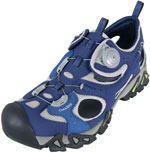 Treksta Kisatchie Sandal ($95,
Treksta Kisatchie Sandal ($95, 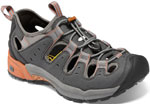 Keen Butte ($90,
Keen Butte ($90,  Chaco Z/2 Vibram Unaweep ($95,
Chaco Z/2 Vibram Unaweep ($95,  Ahnu Reyes ($90,
Ahnu Reyes ($90, 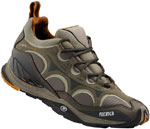 Technica Wasp Low ($100,
Technica Wasp Low ($100, 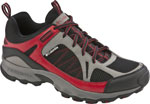 Columbia Switchback ($75,
Columbia Switchback ($75,  Vasque Juxt ($90,
Vasque Juxt ($90, 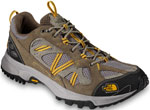 The North Face Assailant ($80,
The North Face Assailant ($80,  Scarpa Epic ($95,
Scarpa Epic ($95,
A third option is aqua socks. They are light weight latex shoes with rubber soles. Great for canoeing and beach-wear. Average cost is $12.00-$16.00. They are perfect for swimming in rocky areas that might hurt your feet.
I have the best kind of sandals, its called calluses!! I walk around bare foot a lot (not during the winter of course!)and after a wile you wont even feel the sand and rocks under you feet!
I love sports, I love nature, I love the Vibram Five Fingers!
I have a pair of source sandals and I love them. I do a lot of water hiking and they are very durable and supportive.
the lightest hicking shoes i ever got was at marties
If the hiking isn’t too heavy of strenuous, try Vibram Five Fingers. they look weird and take a little getting used to, but are extremely light and comfortable.
Sandals like the Treksta Kisatchie sandal are great!, but you don’t
need to pay thet kind of money for them. Sketchers, and Faded Glory
make the same type of sandal, only for 16, to 35 bucks!
I used them, and their just as good as anything!
I think that the Treksta sandals look cool, but I wonder if they come in other colors than blue. They also seem kind of expensive for sandals.
I’m just saying
i think so to 😉
Keen makes some good sandals. Crocs are also good in water sports (boating, summer fishing, etc.) I’m not sure that I would take sandals on a light hike though, that just doesn’t seem very smart.
I gots me some manly steel-toe boots for that!
i had hicking boots with steal toe boots and when i grew out of them they cut, brused my feet, and was just plain un comferble so enless you are finished growing in your feet then get regular boots or for the summer hicking shoes are the way to go and you can get at marties for 80 $